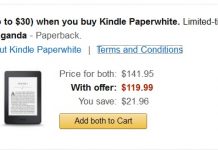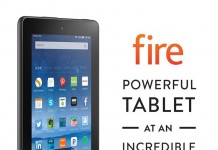![]() Buying an e-reader has become more complex, with several solid options, both in E Ink and tablet-like lines. So how do you choose? That’s where a brand-new, just-launched-yesterday website called Reader Rocket wants to come in.
Buying an e-reader has become more complex, with several solid options, both in E Ink and tablet-like lines. So how do you choose? That’s where a brand-new, just-launched-yesterday website called Reader Rocket wants to come in.

The site is simple. Put two different e-readers head-to-head, and see which one comes out on top. I sat around and tried a lot of different combinations, and basically I agree with their conclusions. They use a variety of criteria including size of bookstore, overall reviews, features, price and battery life.
They give you a detailed report, showing their conclusions, advantages of each and other options to consider.
I like their advantages of each. It takes into account that customers have different needs and that their general recommendation might not be right for everyone.
I also like that you can compare not-like items, allowing you to run a head-to-head between an E Ink device and a tablet. Lots of the buying guides out there only compare like items, but frequently I see people asking the question, “Should I get a Paperwhite or a Fire?” In case you were wondering, Reader Rocket recommends a Paperwhite, but scrolling down to the Advantages section can give a novice a good overview of one type versus the other, and I think that’s valuable information.

If I had to come up with a downside to the site, it’s this: It’s difficult to come up with any comparison with a Kindle product where the Kindle isn’t the winner. I tried lots of combinations, and the only one where I could force Amazon to lose was Nook Simple Touch vs. Kindle Touch. Before the conspiracy theorists come out of the woodwork, Kindle products do often review better than the competition, so it wasn’t a surprising discovery. I’d suggest paying close attention to the Advantages section when comparing anything to a Kindle, so you can make the right decision for you.






























There’s really nothing complicated about buying an e-reader.
If you live in the US, Amazon Kindle Paperwhite or B&N Nook: same price and capability. Alternatively, the Kobo Glo; it’s harder to source but has a strong bookstore and features. Cost is under $125.
If you live outside the US, Kobo Glo, Amazon Paperwhite. Kobo offers library access (Amazon Overdirve is US only); Kobo is available in multiple languages.
If you prefer a tablet to an e-reader, any recent Android or Apple iPad supports apps for the Kindle, Kobo, Nook. A handsome buy is the Google Nexus 7 — great price, open system (not locked to Amazon like the Fire) — and supports Overdrive as well as Kobo, Kindle, Nook. Cost is around $200.
Those of us who are blind or cannot read standard print for some other reason want to participate in the eBook revolution, too. Electronic books offer us the potential for more access to information in a timely manner than has ever been possible before. Unfortunately, eBook producers like Kindle have arbitrarily blocked our access by creating devices we cannot use. I would be delighted if any comparisons of eBook Readers would include accessibility prominently as a criterion. Under those circumstances, Kindle would lose every time.